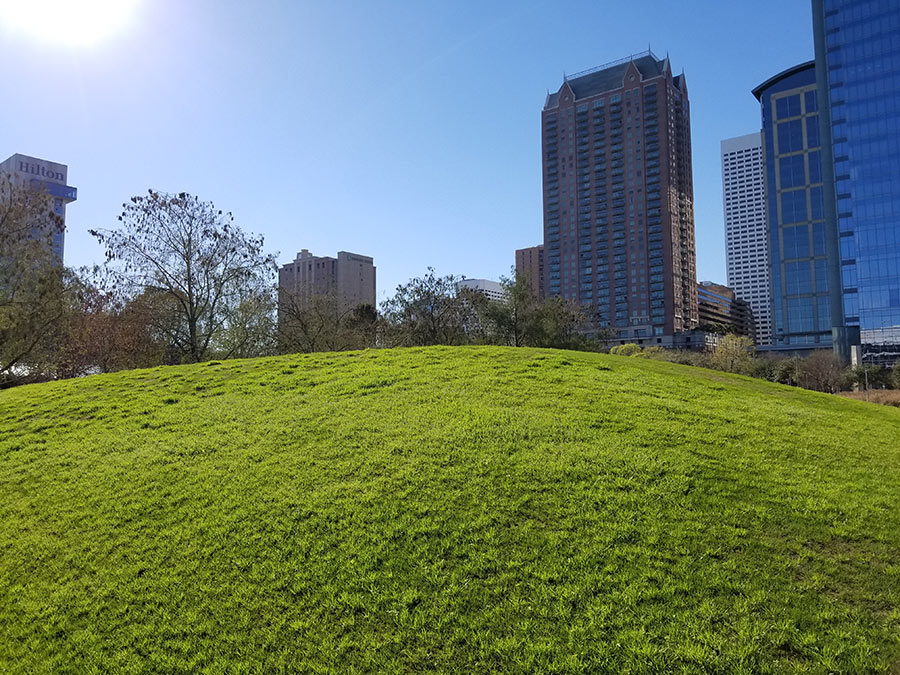
- More Flooding Possible as Thunderstorms Hit Houston Area Today [Houston Chronicle; previously on Swamplot]
- Losses Could Be in the Billions After ‘500-Year Flood’ [Houston Chronicle]
- At Least 4 Deaths in Harris County, 1 in Waller County Blamed on Flooding as Hundreds Flee Their Homes [CNN]
- Eyewitness News Reporter Helped Rescue Man Trapped in High Water on Studemont Street on Live TV [abc13]
- Capturing Houston’s Flooded, Abandoned Freeways [Houston Chronicle]
- Photos of Neighborhood Flooding and Destruction from Houston Residents [Houston Chronicle; previously on Swamplot]
- Could Better Data Keep Houstonians Safe During Floods? [The Urban Edge]
- Phoenix Tower on the Market, Could Fetch $104M According to Real Estate Alert [Realty News Report]
- Realtors Added 11,466 New Listings to the Houston Housing Market in March, Raising Inventory to 3.7 Month Supply, Finds Redfin Corp. [HBJ]
- A Sneak Peek at the Galveston Historic Homes Tour Kicking Off April 30 [Houston Press]
Photo: o texano via Swamplot Flickr Pool
Headlines





Emmet: “240 billion gallons of rain has fallen in the Houston area.” Yeesh. This sort of thing is becoming too frequent.
It’s time to do away with parking minimums and embrace parallel parking. Most Houstonians have gone their whole lives without ever having to parallel park, while in other cities it’s part of everyday life. The result is that we have a city of parking lots that sit half or majority empty most of the time, and when it rains, it floods. These floods have gradually gotten worse with each passing decade as we’ve paved more area. With parallel parking, you still need paved area to accommodate cars, but because the paved areas are not separately owned by different businesses, they are much more flexible in accommodating net total parking demand, hence you end up with less total paved area. Probably also need a maximum impervious coverage requirement for new development if we don’t already have one, so the ground can absorb water instead of holding parking spaces.
@Mike: I don’t think parking differently will make a dent in the flooding. We have to improve drainage and retention.
Anyone else think that Wulfe’s comments are pretty rich, given that developers have run city planning for the last three generations?
Parallel parking is for people that hate cars. I wouldn’t dare leave my car on the street, besides the obvious fact that streets flood, you have other cars passing by that can side swipe you, can kick up debris that can scratch your car, constant dirt that will make you wash your car constantly, careless pedestrians with bags and purses with buckles, tree sap, etc. I’m sure parallel parking is OK if you have a 1989 Honda Civic with three different color body panels, but not a nice new car that you worked hard for.
Let me spell out my above comment a little more easily for people who have trouble managing paragraphs.
–
PARKING MINIMUMS -> BIG PARKING LOTS -> FASTER DRAINAGE -> MORE FLOODING!
–
FEWER/SMALLER PARKING LOTS -> WHERE DO THE CARS GO? -> PARALLEL PARKING -> LESS FLOODING.
Parallel parked cars are the first to float away
There are good reasons to hate parking minimums, but they have nothing to do with flooding. Developers will fill up any space saved by reduced parking minimums with more impervious building square footage. In fact, too many buildings can be worse for sheet flooding. At least a parking lot will let water flow over it.
I agree that Mr. Wulfe commenting on flooding is quite ironic. The City of Houston has consciously kicked the flooding problem down the road for decades by not requiring drainage detention when large tracts are redeveloped. The City “grandfathers” properties that have existing impervious cover from having to provide detention when the property is redeveloped. The justification (and this came straight from a CM) is that the existing stormwater infrastructure back before the City required detention was adequate. Only the new development on virgin forest is responsible for any drainage problems. Of course, this is complete BS as the drainage system has never been adequate.
Now is definitely the time to reverse this rule before things continue to get worse. There is more than enough demand for real estate in the City that we can no longer claim that this rule will inhibit development.
OldSchool, thank you for reading and understanding my comment, but I respectfully disagree. As I mentioned initially, this should go along with a maximum impervious coverage requirement. But even without maximum impervious coverage, if we allow the parking lots to become smaller, there will be less flooding. The reduced impervious surface of all those parking lots is not going to be replaced by extra building square footage, which costs far more to build. Maybe a fraction of it gets replaced by larger buidings, in a few cramped situations. More likely developers will just buy smaller tracts of land, especially considering how expensive land is.
The problem was not really the rain. The problem was that all day Saturday and Sunday we had high winds coming straight from the southeast combined with two very high tides.
By Sunday evening, waves were breaking on the lawn at Clear Lake Park and the boardwalks and bulkheads were completely submerged. Clear Lake, Galveston Bay, the Trinity and San Jacinto rivers and all the bayous were backed up to overflowing before the first drop of rain even fell.
There was nowhere for the water to go so it just piled up on the streets. If we had not experienced two straight days of high southeasterly wind then the flooding would not have occurred
oldskool: How about this? Allow people to reduce parking if that reduction is used for open space? I’ve had several ideas for places I’d like to open but none really worked with the huge amount I have to dedicate to parking. Personally I’d a place with zero parking and a lot of open park-like area. If that means I lose customers that won’t come because they can’t park — oh well. Hopefully I’ll attract just as many people that are walking or biking distance that would enjoy going somewhere that isn’t dominated by a huge chunk of asphalt.
,
Oh, and a property of mine that was build in the 30’s has no parking. It’s literally all building on the lot. And has been like that for 80+ years. Yet when a business tried to open up in there, dealing with the parking minimums has been a nightmare. Even though this is near downtown, new high-rises, light rail, etc. Those rules are insane.
Luckily for all of us Parker’s dedicated drainage fees should save us all any day now
@Jardinero1 – Maybe that was a contributing factor in your area, but not so much in Katy and Sealy.
Parking lots aren’t the problem; Houston’s max rainfall rates and soil type are the culprit you’re looking for. No part of Houston’s soil can absorb 8 inches of rain in 2 or 3 hours, so if its not going to pool where it lands, it has to runoff, meaning you need to manage how it runs off and how much runoff capacity you have. The “floods get worse” only in that there are more people living where the flooding is, and people mind floodwaters (or water pooling) in their house much more than on farmland/forest/wild-land. Upstream development certainly increases the amount of runoff in the bayous, but the solution is bigger bayous not less development/fewer parking lots.
@Cody: I love it. I am on board. More green space would be great, but it would do little to solve the flooding problems. A required detention basin on a one acre property will do more to improve drainage than dozens of smaller patches of green space. Same answer to Mike. It is the big lots that are really the problem and potentially the answer. And given that you can build underground detention (albeit quite expensive compared to using existing sq ft on a lot), it is possible to create lots of new detention by requiring it on all redevelopment of an acre+. It would have a huge impact on drainage and flooding.
juancarlos31, if as you say that the only factors are max rainfall rates and soil type, why is it then also true that upstream development “certainly increases the amount of runoff”? The reason upstream development increases the amount of runoff is because much of it is impervious, which is the same reason why lots of parking lots worsen flooding. And yes, flooding has gotten worse in Houston over the decades, as is widely recognized. Soil can’t absorb all of it, but it can absorb much more than concrete.
@Superdave,
I live between Armand and Taylor Bayous and the flooding was not that bad. It was much worse northwest and far north for the reasons I stated.
All the water in Harris and Montgomery counties ultimately finds its way out via Galveston Bay. If the wind and the tide push the water up five feet, in Galveston Bay, Clear Creek and the San Jacinto River, that means that everything upstream, many miles upstream, is going to be pushed up by five feet or more. Most of the rain fell in the north and northwest and there it has stayed because it can not flow out. Clear Lake and Galveston Bay are still up about 3 feet and the wind is still gently out of the south to southeast. The water won’t fall until the wind changes direction or stops.
Sylvester Turner and Annise Parker both got elected using developer money so developers don’t have to build detention to correspond with what they’ve elevated. They can literally erect a city within a city and never have to add detention. They don’t even have to use permeable concrete which is only slightly more expensive than regular concrete, plus they get millions in free tax payer money from the TIRZes.
–
Someone needs to go to jail for this to change.
Native prairies, which much of Houston was originally composed of, have the ability to slow down and absorb a lot of water. On a small scale little benefit would be had but on a large scale, say a minimum requirement per some scientifically determined amount, could be part of an overall flood control plan. After all turf grass roots reach mere inches into the soil while little bluestem have roots that reach many many feet deep thus increasing the soils ability to hold water. There is a sustainable way forward for Houston but it requires not just individual action but city, county, state, and federal action to force individuals to look past short term gain towards long term sustainability. If profit in the short term is our sole motivation then we are all destined for trouble.